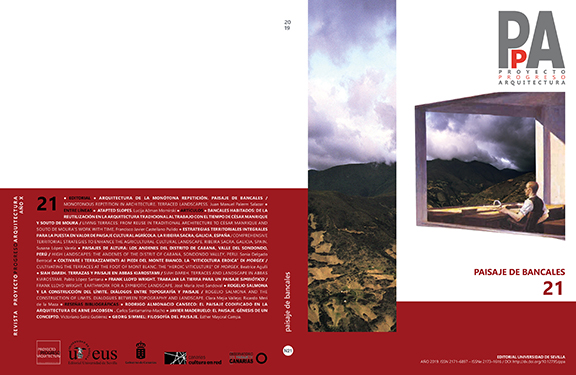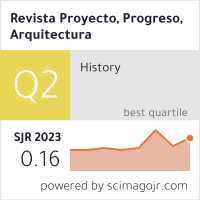ADAPTED SLOPES
DOI:
https://doi.org/10.12795/ppa.2019.i21.01Palabras clave:
terraced landscapes, adapted slopes, architecture, urbanismResumen
SUMMARY This article focuses on three research questions: 1) Were terraced landscapes built in the analytical or creative phase of the first human intervention in a place? 2) Does the geometry of the slopes adapted as a terraced landscape apply in a conscious planning process? 3) What are the patterns and relationships between buildings, settlements, and terraced landscapes? The first issue was examined at the archaeological site Lepenski Vir, where a settlement and trapezoidal huts were built on terraces. The terraces were designed more in the creative phase than in the analytical phase because some of the terraces already had a shape that corresponded to and followed the shape of the huts. The answer to the second question is based on an understanding of the importance of horizontal and vertical measurements, their symbolism, and the origins of agriculture. The applied geometry of the slope is one of the indicators that the terraces were built on the basis of conscious planning and rational order, which is an instrument of basic economics and land delimitation issues. The types of relationships between buildings, settlements, and terraces are numerous, and sometimes they can represent a pattern that occurs in a particular region. Because the aim of civil and other initiatives is to protect terraced landscapes from the prejudice of marginality and ignorance, extended studies may be expected in this vast field of case studies.
Descargas
Citas
ANTHONIOZ, Stéphanie. Ziggurat, origine et symbole. In: Lumière et vie. 2009, nº 281, pp. 73–77.
AŽMAN MOMIRSKI, Lucija; BERČIČ, Tomaž. Ignored Regions: Slovenian Terraced Landscapes. In: Annales, Series Historia et Sociologia. 2016, vol. 26, nº 3, pp. 399–418. DOI: 10.19233/ASHS.2016.37
BORIĆ, Dušan. Places That Created Time in the Danube Gorges and Beyond, c. 9000–5500 BC. In: Documenta Praehistorica. 1999, nº 26, pp. 41–70.
BORIĆ, Dušan. Body Metamorphosis and Animality: Volatile Bodies and Boulder Artworks from Lepenski Vir. In: Cambridge Archaeological Journal. 2005, vol. 15, nº 1, pp. 35–69. DOI: 10.1017/S095977430500003X
BORIĆ, Dušan. The House between Grand Narratives and Microhistories: A House Society in the Balkans. In: R. A. BECK, Jr., ed. The Durable House: House Society Models in Archaeology. Carbondale, IL: Center for Archaeological Investigations, Occasional Paper nº 35, 2007, pp. 97–129.
BORIĆ, Dušan. Deathways at Lepenski Vir: Patterns in Mortuary Practice. Belgrade: Serbian Archaeological Society, 2016.
BORIĆ, Dušan; MIRACLE, Preston. Mesolithic and Neolithic (Dis)continuities in the Danube Gorges: New AMS Dates from Padina and Hajdučka Vodenica (Serbia). In: Oxford Journal of Archaeology. 2004, vol 23, nº 4, pp. 341–371.
BONSALL, Clive; RADOVANOVIĆ, Ivana; ROKSANDIĆ, Mirjana; COOK, Gordon; HIGHAM, Thomas; PICKARD, Catriona. Dating Burial Practices and Architecture at Lepenski Vir. In: Clive BONSALL; Vasile BORONEANŢ; Ivana RADOVANOVIĆ, eds. The Iron Gates in Prehistory. New Perspectives. Oxford: Archaeopress, 2008, pp. 175–204.
CARSTEN, Janet; HUGH-JONES, Stephen. About the House: Lévi-Strauss and Beyond. Cambridge: Cambridge University Press, 1995.
CIGLENEČKI, Slavko. Polis Noricum. Podsreda, Slovenia: Zavod Spominski park Trebče, 1992.
DINU, Alexandru. Mesolithic Fish and Fishermen of the Lower Danube (Iron Gates). In: Documenta Praehistoric. 2010, nº 37, pp. 299–310.
Encyclopaedia Britannica, 2019 [accessed September 8th, 2019]. Available at: https://www.britannica.com/technology/ziggurat
van ESS, Margarete; NEEF, Reinder. Rohstoff Schilf. In: Nicola
CRÜSEMANN, Margarete van ESS, Markus HILGERT, Beate SALJE, Uruk–5000 Jahre Megacity. Curt-Engelhorn-Stiftung, Deutschen Archäologischen Institut, Deutschen Orient-Gesellschaft e. V., Vorderasiatischen Museum, Reiss-Engelhorn-Museen Mannheim, Staatliche Museen zu Berlin, 2013, pp. 114–115.
FOWLER, Chris. Landscape and Personhood. In: Bruno DAVID; Julian THOMAS, eds. Handbook of Landscape Archaeology. Walnut Creek, CA: Left Coast Press, 2008, pp. 291–299.
IVETIĆ, Egidio. Istra kroz vrijeme: pregled povijesti Istre sa osvrtom na grad Rijeku. Rovinj, Croatia: Centar za povijesna istraživanja, 2009.
KOŠIR, Fedja. Zamisel mesta. Ljubljana: Slovenska matica, 1993.
KOŠIR, Fedja. Ob začetku oblik o naselbinskem sestavu Lepenskega vira. In: Fedja
KOŠIR. Izbrani članki. Ljubljana: Fakulteta za arhitekturo Univerze v Ljubljani, 2000, pp. 33–44.
LENDERING, Jona. Etemenanki (the “Tower of Babel”). In: Articles on ancient history. Livius.org [accessed September 8th, 2019]. Available at: https://web.archive.org/web/20170523034458/https://www.livius.org/articles/place/etemenanki
LIKAR, Darko. An Architectural and Urban-Planning Perspective on Cultivated Terraces in Northern Istria. In: Annales, Series Historia et Sociologia. 2017, vol. 27, nº 1, pp. 131–146. DOI: 10.19233/ASHS.2017.11
MIHOVILIĆ, Kristina. Istra kroz vrijeme. Rovinj: Centar za povijesna istraživanja. Collana degli Atti – nº 30, 2009.
ODAR, Boštjan. Naselbina na Donački gori obljudena v času največjega razcveta Novega kraljestva v Egiptu. In: Kozjansko.info. 27 October 2016, 23:31 [accessed September 2nd, 2019]. Available at: http://kozjansko.info/2016/10/naselbina-na-donacki-gori-obljudena-v-casu-najvecjega-razcveta-novega-kraljestva-v-egiptu/
Online Etymology Dictionary [accessed August 29th, 2019]. Available at: https://www.etymonline.com/
PANKOVIĆ, Vladan; MRDJEN, Milan; KRMAR, Miodrag. Was Lepenski Vir an Ancient Sun or Pleiades Observatory? In: arXiv. Cornell University. 6 Jan 2015 [accessed July 27th, 2018]. Available at: https://arxiv.org/abs/1501.01108
PRICE, T. Douglas; BORIĆ, Dušan. Farmers and Foragers in the Danube Gorges: Mobility, Contact and Exchange. Paper presented at the Annual Meeting of the Society for American Archaeology, Montreal, 2004.
RADOVANOVIĆ, Ivana. The Iron Gates Mesolithic. Ann Arbor, MI: Archaeological Series 11. International Monographs in Prehistory, 1996.
RADOVANOVIĆ, Ivana. The Culture of Lepenski Vir: A Contribution to the Interpretation of Its Ideological Aspects. In: Antidoron Dragoslavo Srejovici completis LXV annis ad amicis, collegis, discipulis oblatum. Belgrade: Center for Archaeological Research, University of Belgrade, 1997, pp. 87–93.
RADOVANOVIĆ, Ivana. Houses and Burials at Lepenski Vir. In: European Journal of Archaeology. 2000, vol. 3, nº 3, pp. 330–349.
RUSU, Aurelian. Lepenski Vir-Schela Cladovei Culture’s Chronology and its Interpretation. In: Brukenthal. Acta Musei. 2011, 6.1, pp. 7–23.
Snoj, Marko. Slovenski etimološki slovar. Ljubljana: Mladinska knjiga, 1997.
SREJOVIĆ, Dragoslav. Lepenski Vir: Nova praistorijska kultura u Podunavlju. Belgrade: Srpska književna zadruga, 1969.
SREJOVIĆ, Dragoslav. Europe’s First Monumental Sculpture: New Discoveries at Lepenski Vir. London: Thames and Hudson, 1972.
SUMMERS, David. Real Spaces. World Art History and the Rise of Western Modernism. London: Phaidon Press, 2003.
UNESCO, 2019 [accessed August 29th, 2019]. Available at: http://whc.unesco.org/en/list/113
YAPA, Kashyapa A. Reducing Climate and Other Risks through Nature-Aided and Faith-Based Experiences by Peruvian Terrace Farmers. In: Annales, Series Historia et Sociologia. 2016, vol 26, nº 3, pp. 389–398. DOI: 10.19233/ASHS.2016.30
ŽIVALJEVIĆ, Ivana. Concepts of the body and personhood in the Mesolithic-Neolithic Danube Gorges: interpreting animal remains from human burials. In: Етноантрополошки проблеми, 2015, y. 10 (3), pp. 675–699.
Descargas
Publicado
Cómo citar
Número
Sección
Licencia
Las ediciones impresa y electrónica de esta Revista son editadas por el Secretariado de Publicaciones de la Universidad de Sevilla, siendo necesario citar la procedencia en cualquier reproducción parcial o total.
Salvo indicación contraria, todos los contenidos de la edición electrónica se distribuyen bajo una licencia de uso y distribución “Creative Commons Atribución-NoComercial-SinDerivar 4.0 Internacional” ![]() . Puede consultar desde aquí la versión informativa y el texto legal de la licencia. Esta circunstancia ha de hacerse constar expresamente de esta forma cuando sea necesario.
. Puede consultar desde aquí la versión informativa y el texto legal de la licencia. Esta circunstancia ha de hacerse constar expresamente de esta forma cuando sea necesario.
Los autores/as que publiquen en esta revista aceptan las siguientes condiciones:
- Los autores/as conservan los derechos de autor y ceden a la revista el derecho de la primera publicación, con el trabajo registrado con la licencia de atribución de Creative Commons, que permite a terceros utilizar lo publicado siempre que mencionen la autoría del trabajo y a la primera publicación en esta revista.
- Los autores/as pueden realizar otros acuerdos contractuales independientes y adicionales para la distribución no exclusiva de la versión del artículo publicado en esta revista (p. ej., incluirlo en un repositorio institucional o publicarlo en un libro) siempre que indiquen claramente que el trabajo se publicó por primera vez en esta revista.
- Se permite y recomienda a los autores/as a publicar su trabajo en Internet (por ejemplo en páginas institucionales o personales) antes y durante el proceso de revisión y publicación, ya que puede conducir a intercambios productivos y a una mayor y más rápida difusión del trabajo publicado (vea The Effect of Open Access).









